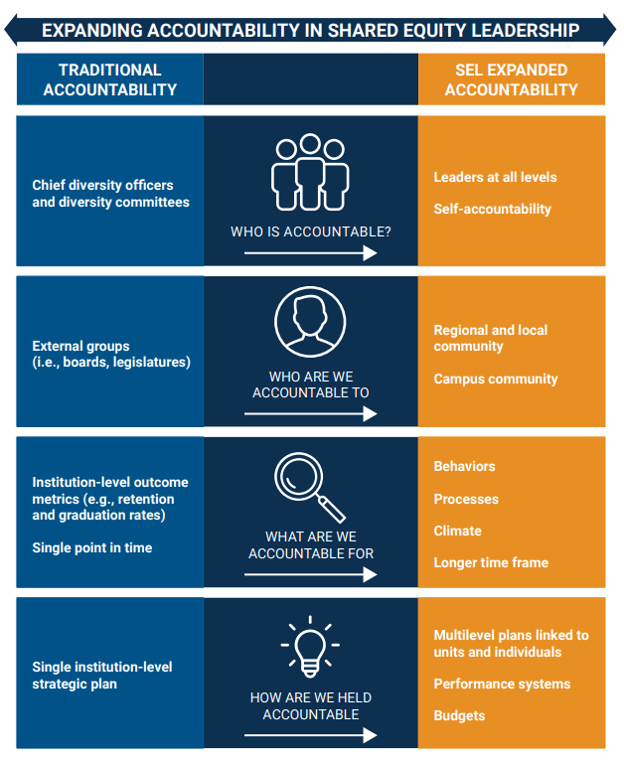More than two years after the murder of George Floyd and the racial reckoning that arose in its wake, urgency around equity-minded and anti-racist work in higher education continues to increase.
Student and community stakeholders are pressing college and university leaders for evidence of action and increased accountability around diversity, equity, and inclusion (DEI) work. Data that show progress on key DEI indicators are becoming an expectation—not just demonstrating that the work is occurring, but also whether it is making a difference. National players are starting to chime in, including funders such as the Bill & Melinda Gates Foundation, which is looking at equity gaps; the Alfred P. Sloan Foundation and its focus on equitable pathways; and policymakers such as the NASH Equity Action Framework. Even accreditors are weighing in through the Council for Higher Education Accreditation’s commitment to hold institutions accountable for equitable outcomes. Projects such as the Equity Scorecard have been pressuring campuses for years to look at and track data disaggregated by race and ethnicity to ensure that racial equity gaps are narrowing and not persisting.
Making progress on narrowing gaps and creating more inclusive and anti-racist campus environments will mean spreading the work out to more faculty, staff, and administrators on campus rather than marginalizing it to one or two offices. Our recent research documents how campuses are distributing responsibility for DEI work to have a greater impact through shared equity leadership (SEL).
SEL is a leadership approach through which individuals embrace a personal journey toward critical consciousness to become a different type of leader. Collectively, faculty, administrator, and staff leaders work toward embodying new values and enacting a set of practices that form new relationships and understandings. The ultimate goal is to dismantle current systems and structures that inhibit equitable outcomes based on race and other social identities.
Through our conversations with over 100 leaders at eight campuses across the country, we have found that accountability efforts also need to change dramatically within SEL by expanding notions of who is accountable (and to whom), what they are accountable for, and how they are held accountable.

Our findings suggest that leaders across higher education need to revise their current plans for monitoring DEI efforts. Every stakeholder has a responsibility in holding themselves and their colleagues accountable for making campuses more equitable. Based on our latest report in the On Shared Equity Leadership series, we offer up the following steps:
Ensure the board is well-versed in DEI and is regularly monitoring progress. Presidents and cabinets should ensure that there is a DEI subcommittee that is educated about DEI to provide oversight to the board of trustees. Too often boards have not been brought into DEI work as directly as they could be, but a commitment from the board is paramount.
Rethink key stakeholder commitments and increase transparency. Currently, DEI accountability is often limited to the cabinet, which reports progress to the president, board, and fellow cabinet-level colleagues. Often, any progress (or lack of) stays with this small group of leaders, rather than being shared with the campus at large. Instead, the cabinet should explore how they can share results with key stakeholders with a vested interest in DEI progress such as students, community members, local and state government, business leaders, and alumni.
Create task forces to reexamine equity metrics. Campus leaders tend to hold themselves accountable for a very narrow set of DEI success metrics, such as closing gaps in retention and graduation of students by race (if they even track these metrics—many campuses still do not). This narrow focus does not capture the work needed to ensure the essential culture change to make campuses more equitable and inclusive for minoritized students, faculty, and staff. Our report outlines a set of measures that some campuses are experimenting with to better monitor progress toward culture change. A presidential task force could examine these metrics and others to better reflect the transformational changes that are needed.
Educate colleagues about expanded metrics. Campus data efforts often reflect outdated knowledge about how to understand DEI goals and progress. Campus leaders should call on campus DEI experts for help in understanding the most current thinking on climate or behavior measures.
Include DEI experts in accountability planning and implementation efforts. While DEI advocates have the expertise to educate their colleagues on expanded metrics, they must also be included in groups that develop accountability plans. Campus leaders should also look to faculty members whose research agendas include race and equity and incorporate their knowledge into planning processes. Too often, campus leaders overlook the robust expertise among their own faculty instead of taking advantage of these resident experts.
Establish dashboards for communicating and sharing progress. If data are not easily accessible, it will be harder to communicate accountability and to make data useful for other groups. Some sort of central, publicly available resource for sharing progress—such as a dashboard on the university website—will help all stakeholders monitor progress.
Hold regular campus-wide forums to share updates on DEI progress and obtain stakeholder feedback. Regular campus-wide updates on DEI progress help promote transparency, build trust, and provide a space for faculty, students, and staff to provide feedback and maintain pressure for forward momentum. Accountability means that every group on campus is seeing the data and thinking about ways they can act to close equity gaps.
Our report shares more details and examples of how campuses are changing their approaches to DEI accountability as they change their leadership strategies. The report also discusses common challenges and tensions that campuses are navigating as they develop new accountability systems and provides a toolkit to help campus groups think through what accountability should look like as they implement SEL.
The shared equity leadership work is supported by generous funding from the Arthur Vining Davis Foundations.
If you have any questions or comments about this blog post, please contact us.




